
Ophrys apifera, known in Europe as the bee orchid, is a perennial herbaceous plant of the genus Ophrys, in the family of Orchidaceae. It serves as an example of sexually deceptive pollination and floral mimicry, a highly selective and highly evolved plant–pollinator relationship.

The genus Ophrys is a large group of orchids from the alliance Orchis in the subtribe Orchidinae. They are widespread across much of Europe, North Africa, Caucasus, the Canary Islands, and the Middle East as far east as Turkmenistan.
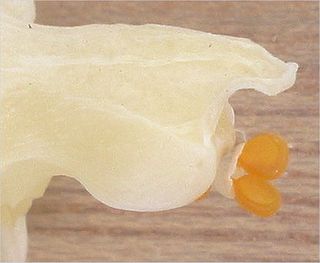
A pollinium is a coherent mass of pollen grains in a plant that are the product of only one anther, but are transferred, during pollination, as a single unit. This is regularly seen in plants such as orchids and many species of milkweeds (Asclepiadoideae). Usage of the term differs: in some orchids two masses of pollen are well attached to one another, but in other orchids there are two halves each of which is sometimes referred to as a pollinium.

Ophrys lutea, the yellow bee-orchid, is a species of orchid native to southern Europe, North Africa, and the Middle East, the range extending from Portugal and Morocco to Syria.

Pseudocopulation is a behavior similar to copulation that serves a reproductive function for one or both participants but does not involve actual sexual union between the individuals. It is most generally applied to a pollinator attempting to copulate with a flower adapted to mimic a potential female mate. The resemblance may be visual, but the key stimuli are often chemical and tactile. The form of mimicry in plants that deceives an insect into pseudocopulation is called Pouyannian mimicry after the French lawyer and amateur botanist Maurice-Alexandre Pouyanne.

Microtis, commonly known as onion orchids or mignonette orchids is a genus of about 20 species of plants in the orchid family, Orchidaceae. Onion orchids are terrestrial herbs with a single leaf at the base of the plant. They are similar to orchids in the genus Prasophyllum in that they have an onion-like leaf. The flowers are small but often scented and attractive to their insect pollinators. They are widespread in Asia, Australia and some Pacific islands.

Ophrys insectifera, the fly orchid, is a species of orchid and the type species of the genus Ophrys. It is remarkable as an example of the use of sexually deceptive pollination and floral mimicry, as well as a highly selective and highly evolved plant–pollinator relationship.

Drakaea is a genus of 10 species in the plant family Orchidaceae commonly known as hammer orchids. All ten species occur only in the south-west of Western Australia. Hammer orchids are characterised by an insectoid labellum that is attached to a narrow, hinged stem, which holds it aloft. The stem can hinge only backwards, where the broadly winged column carries the pollen and stigma. Each species of hammer orchid is pollinated by a specific species of thynnid wasp. Thynnid wasps are unusual in that the female is flightless and mating occurs when the male carries a female away to a source of food. The labellum of the orchid resembles a female thynnid wasp in shape, colour and scent. Insect pollination involving sexual attraction is common in orchids but the interaction between the male thynnid wasp and the hammer orchid is unique in that it involves the insect trying to fly away with a part of the flower.
Sexual mimicry occurs when one sex mimics the opposite sex in its behavior, appearance, or chemical signalling.

Ophrys bombyliflora, the bumblebee orchid, is a species of Ophrys, native from the Mediterranean region from Portugal and the Canary Islands to Turkey and Lebanon. The genus name Ophrys is from the Greek in reference to the hairy lips of the flowers of this genus; the specific epithet bombyliflora is from the Greek bombylios (bumblebee) in reference to the appearance of the flowers of this species.
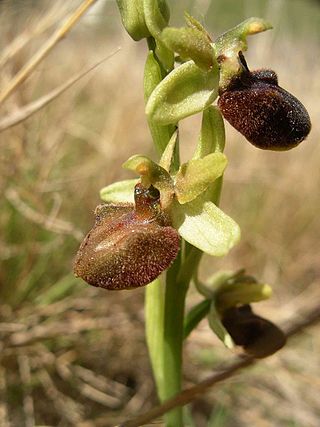
Ophrys sphegodes, commonly known as the early spider-orchid, is a species of sexually-deceptive orchid native to Europe and the Middle East. It is a very varied species with many subspecies recognised.

Pouyannian mimicry is a form of mimicry in plants that deceives an insect into attempting to copulate with a flower. The flower mimics a potential female mate of a male insect, which then serves the plant as a pollinator. The mechanism is named after the French lawyer and amateur botanist Maurice-Alexandre Pouyanne. The resemblance that he noted is visual, but the key stimuli that deceive the pollinator are often chemical and tactile.
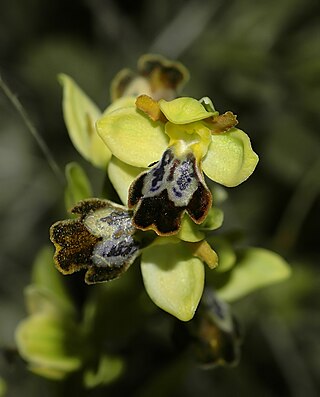
Ophrys fusca, commonly known as the sombre bee-orchid or the dark bee-orchid, is a species of orchid native to the Mediterranean from southwestern Europe and northern Africa to western Asia. Most subspecies of the Ophrys fusca are pollinated by males Andrena bees.
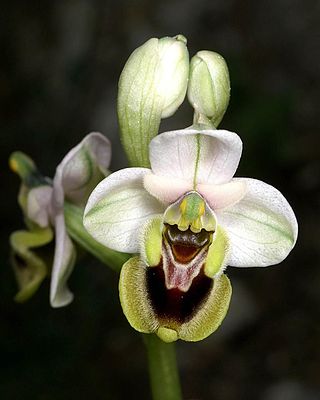
Ophrys tenthredinifera, the sawfly orchid, is a terrestrial species of orchid native to the Mediterranean region from Portugal and Morocco to Turkey. The common name refers to a purported resemblance between the flower and the sawfly, a wasp-like insect.

Spiculaea is a genus of plants defined by a single species, Spiculaea ciliata, commonly known as elbow orchid, and allied to the family Orchidaceae. Endemic to the south-west of Western Australia, the species is unusual in a number of respects; it grows in shallow soil on granite rock outcrops, grows and flowers in the hottest months of the year and has a unique method of using thynnid wasps as pollinators.

In evolutionary biology, mimicry in plants is where a plant evolves to resemble another organism physically or chemically. Mimicry in plants has been studied far less than mimicry in animals. It may provide protection against herbivory, or may deceptively encourage mutualists, like pollinators, to provide a service without offering a reward in return.

Ophrys speculum, the mirror orchid, is a species of Ophrys distributed throughout the Mediterranean that is pollinated exclusively by a single species of scoliid wasp.

Argogorytes mystaceus is a species of solitary wasp in the family Crabronidae.
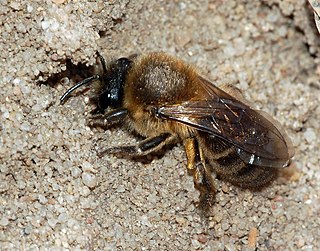
Colletes cunicularius, the vernal colletes or spring mining bee, is a species of solitary bee from the family Colletidae which is widespread in the Palearctic from Britain to the Pacific Ocean which nests in areas of open, sandy soil.

The pollination of orchids is a complex chapter in the biology of this family of plants that are distinguished by the complexity of their flowers and by intricate ecological interactions with their pollinator agents. It has captured the attention of numerous scientists over time, including Charles Darwin, father of the theory of evolution by natural selection. Darwin published in 1862 the first observations of the fundamental role of insects in orchid pollination, in his book The Fertilization of Orchids. Darwin stated that the varied stratagems orchids use to attract their pollinators transcend the imagination of any human being.


















